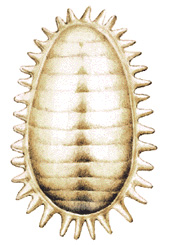Scale insect is one of many kinds of sucking insects that feed on plants. Scale insects cluster on plants, sucking out the juices through their tiny, tubelike beaks. They may weaken a plant so much that it dies.

The female scale insect does most of the damage. The adult male has no mouth and cannot feed. It lives long enough only to fertilize the female’s eggs. Immature males feed for a short time and can do some damage. Most female scale insects are oval-shaped. They are from 0.04 to 1 inch (1 millimeter to 2.5 centimeters) long, depending on the species. The scale insect gets its name from the waxy or scaly shell that usually covers its body. Some scale insects lack eyes, feelers, and legs and rarely move.
Scientists know of more than 2,000 kinds of scale insects, over 400 of which live in the United States. The San Jose scale, one of the best-known and most harmful kinds, feeds on many fruit trees and shrubs. It was first found in the United States near San Jose, California, in about 1870 (see San Jose scale). Another scale insect that attacks fruit trees, the cottony cushion scale, seemed likely at one time to wipe out all the citrus trees in California (see Insect (Insect control)).
Some scale insects are useful. Shellac, a varnish, comes from a scale called the lac insect (see Lac). Cochineal, a dye, comes from the cochineal scale. One kind of scale insect is used as jewelry. This insect covers itself with shells called ground pearls.
See also Whitefly.
